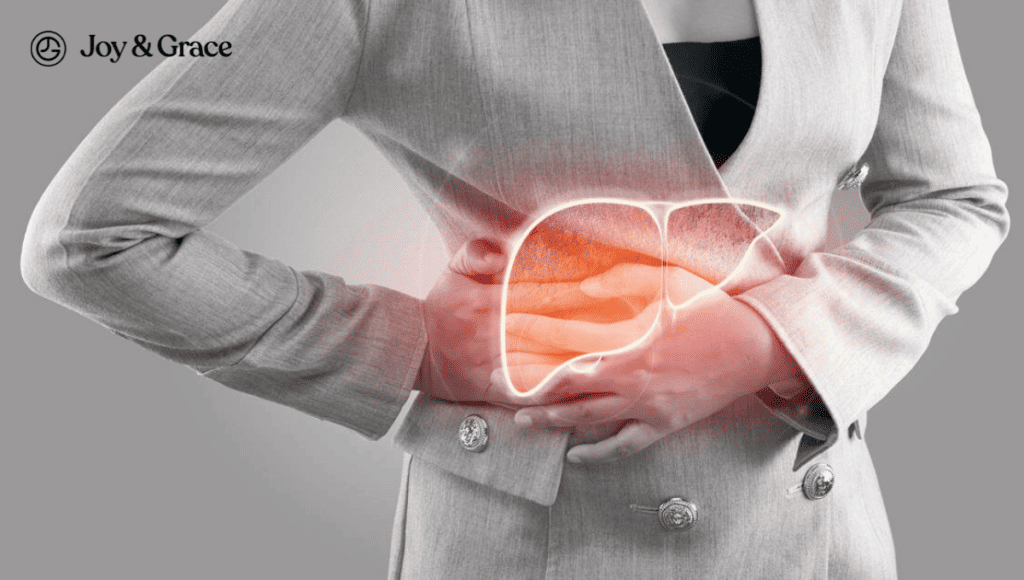Every pain is a signal worth paying attention to regarding health and fitness. Shoulder and rib pain on the right side might seem peculiar as a pair, but these related pains can signal various underlying conditions.
When a doctor tries to figure out what's wrong, it helps to know how different kinds of pain are related.
Can Shoulder Pain on the Right Side Affect Your Ribs?
Typically, pain in the right shoulder and rib area is more often linked to relatively harmless issues than serious medical conditions. The two most common culprits are bad posture and simultaneous straining.
- Bad Posture
Poor posture is a frequent cause of pain in both the shoulder and rib areas. When you slouch or hunch over, it places undue stress on the muscles, ligaments, and nerves in these regions. This can lead to tension and discomfort, especially if maintained for extended periods. This constant strain can cause chronic pain in the shoulder and ribs over time, and it could lead to other joint problems as well.
Also, shoulder pain can sometimes make you change your position to make it better or less painful. This change in position can strain the ribs without meaning to, making the pain and discomfort worse in both the shoulder and rib areas.
It creates a cycle where pain in one area leads to changes in posture, aggravating pain in another area.
- Simultaneous Straining
Physical activities like rowing, weightlifting, or heavy lifting can strain both the shoulder and ribs simultaneously. These movements engage muscles that connect the shoulder to the ribs, causing strain when overused or moved awkwardly. This leads to pain in both areas. The pain is often felt as a dull ache that worsens with movement.

While these conditions are the usual culprits for right shoulder and rib pain, they're not the only possibilities.
It must be noted that, in some cases, the pain could stem from more severe issues like a significant bruise or fracture, or it might even originate from internal organs, mainly if other additional symptoms are present.
Let’s review these in more detail.
Digging Deeper Into the Causes
Bruises and Breaks
While overexertion typically leads to mild muscle strains that often improve with rest and self-care, the situation is different for bruises and breaks. These injuries might require more medical attention:
- Bruise or Contusion
A bruise or contusion in the rib area, resulting from a less severe but significant blow, can also cause pain that extends to the shoulder. When the rib cage takes a hard hit, the soft tissues around the ribs can get hurt. This can send pain signals to the shoulder.
- Rib Fracture
A rib fracture is one of the typical outcomes of physical trauma affecting this area. A fall or a direct blow to the chest mainly causes these fractures. They can cause intense pain that worsens when you breathe deeply, cough, or laugh. A broken rib doesn't just hurt where it is. The pain can spread to the shoulder because the ribs and shoulders share several muscle groups and nerves.
Medical attention is crucial to ensuring adequate recovery from bruises and breaks. Resting and taking over-the-counter medicines may help, but seeing a doctor is essential to prevent issues and recover faster. So, if you have pain in your shoulder and ribs on the right side, it's essential to know what's causing it and how critical good health care is.
But what if you haven’t trained recently, are sure you have good overall posture, and don’t recall any recent injuries? Could the pain be coming from the internal organs? Well, yes, it could.
What Can Cause Shoulder Rib Pain Without Injury?
Shoulder and rib pain on the right side isn't always due to a physical injury. Various internal conditions can lead to such discomfort, some of which might be surprising. These problems can range from problems with the liver to gas buildup. Each of these causes pain differently.
1. An Errant Gallbladder

The gallbladder, a small organ beneath the liver, is crucial to digestion. Sometimes, this organ can cause problems, leading to shoulder and rib pain on the right side. When gallstones irritate the bile ducts coming from the gallbladder, they lead to cholecystitis. It causes severe pain in the upper right abdomen (near the ribs) and under the right shoulder blade.
The pain in the right upper quadrant of the abdomen often worsens quickly and moves to the right shoulder. Given the location of the gallbladder, this discomfort can be easily misconstrued as shoulder or rib pain. It's important to know that these gallbladder problems must be treated right away because they can lead to further problems if they aren't.
Other usual symptoms of gallbladder issues include:
- Nausea
- Vomiting
- Fever
- Yellowish discoloration of the skin or whites of the eye, known as jaundice
2. Liver Issues
Closely linked to gallbladder function, the liver can also be a source of shoulder and rib pain on the right side. Liver inflammation, liver abscess, or fatty liver disease can cause shoulder and rib pain. In these cases, pain is usually felt in the upper right abdomen and can radiate to the right shoulder and the area under the right rib cage.
When someone has a liver disease, the organ can get bigger, putting pressure on the ribs and shoulder. This can be painful. Also, an inflamed liver can irritate the diaphragm, a big muscle between the chest and the abdomen. It can cause pain in the shoulder area.
Other symptoms that point to liver issues include:
- Swelling (edema)
- Yellowing of the skin or eyes
- Light-colored stools
- Very dark-colored urine
3. Gas Problems
There is no direct evidence that gas problems can cause shoulder and rib pain on the right side.
Yet, the close relationship of abdominal contents to the diaphragm could open up the possibility of referred pain. Studies on the leftover gas from laparoscopic surgeries, which are known to cause referred shoulder and upper abdominal pain, serve as an illustration of this. The accumulation of gas irritates the phrenic nerve, thus causing the pain.
What Kind of Doctor Should You See for Rib and Shoulder Pain?

If you have pain in your right shoulder and ribs, you need to find the right doctor based on what you think is causing the pain. Different types of doctors can help with this kind of pain and make sure you get the best medical care and treatment possible.
- Primary Care Physician:
Usually, a primary care physician or a family doctor is the first stop. These doctors can do a general checkup, determine what's the likely cause of pain, and send you to the right experts if needed. Primary care physicians can usually handle the treatment plan alone if your illness or injury isn't too severe.
- Orthopedist:
A visit to an orthopedic specialist will be warranted if the pain is suspected to stem specifically from a muscle or bone issue, such as a bruise or fracture. Orthopedic doctors are trained to find and treat bone, joint, ligament, tendon, and muscle problems. This system is called the musculoskeletal system.
- Gastroenterologist:
You should see a gastroenterologist if your shoulder and rib pain also includes abdominal discomfort. These types of doctors are specialists in the gastrointestinal system.
Ultimately, the type of doctor best suited to treat right shoulder and rib pain depends a lot on what is causing it. So, an excellent initial assessment is critical to find the right expert for your needs.
How to Fix Shoulder and Rib Pain on the Right Side?

Treatment options for shoulder and rib pain on the right side mainly depend on the pain's cause. Relief from this type of pain can be achieved through various methods.
- Maintain a Healthy Lifestyle
Maintaining a healthy lifestyle can often mitigate mild shoulder and rib pain. Regular exercise can lessen the strains and muscle stress that cause this pain by strengthening the core and improving posture.
In fact, in a study among patients with shoulder pain, strength training was shown to be effective in mitigating the pain.
- Nonsteroidal Anti-inflammatory Drugs (NSAIDs)
Over-the-counter painkillers like NSAIDs can treat mild to moderate pain. However, considering potential side effects, these should be used under professional medical advice. A study comparing ibuprofen and acetaminophen showed that both drugs can help reduce pain related to the rotator cuff.
- Physical Therapy
Physical therapies can be beneficial for musculoskeletal-related pain. A study showed that supervised physical therapy has significant benefit in both short and long-term for patients with mixed shoulder disorders.
- Ultrasound Deep Heat Therapy
Ultrasound deep heat therapy may reduce pain and enhance function. In one study, it was shown that this treatment modality has significantly improved pain scores. However, the therapy must be combined with exercise or other physical modalities.
- Heat and Cold Therapy
Research shows that both heat and cold therapies can instantly enhance the pain threshold in a healthy shoulder.
Heat increases blood flow to the area to assist in healing. Cold therapy can constrict the vessels on initial treatment and open the vessels after 10 minutes of treatment, protecting the tissue from damage.
- Treatment of Underlying Conditions
If an internal condition is causing the pain, the treatment will address that underlying condition. For instance, if you have gallstones, you might need medicine to break up the stones or surgery to remove your gallbladder. Liver problems must be treated with the right medicines, food changes, or surgery.
For mild pain, alternative treatments like acupuncture, massage, or yoga might also help, especially for people who don't want to use drugs.
Sometimes, a proper "fix" for shoulder and rib pain on the right side is complicated and requires a personalized method based on the root cause. Working closely with healthcare workers is essential to developing an effective medical treatment plan in those cases.
Risk Factors for Shoulder and Rib Pain on the Right Side
Certain factors increase the likelihood of experiencing shoulder and rib pain on the right side. Knowing these risk factors can help you avoid illness and obtain treatment quickly, improving your health and daily life.
- Age
Age is a significant risk factor for many conditions that lead to shoulder and rib pain. As the body ages, the risk of degenerative disc disease increases. Each condition can contribute to shoulder and rib pain, making age an important consideration. Evidence shows that the lifetime prevalence of shoulder pain in middle-aged women is around 27%.
- Occupational and lifestyle factors
Occupational and lifestyle factors also influence the risk of developing such pain, as we mentioned earlier. Repetitive shoulder movements or poor posture at work or play can cause musculoskeletal strain and pain. In fact, according to a study, among the identified factors that increase the incidence of shoulder pain are physical load, awkward postures, repetitive movements, and duration of employment.
- History of underlying medical conditions
Individuals with a history of certain medical conditions are more likely to experience shoulder and rib pain. For example, shoulder and rib pain is more likely in people with gallstones and liver diseases, as discussed earlier.
If you know about these risk factors, you can change your lifestyle to make your right shoulder and ribs less likely to hurt.
Exercise, healthy eating, and maintaining a healthy weight can all help to prevent this kind of pain.
If the pain is stubborn, seeing a medical professional is always advisable.
Takeaway
Many things can cause shoulder and rib pain, from bruises and strains to problems with the stomach and liver. Age, work, pre-existing medical conditions, and lifestyle choices can all make it more likely to have this kind of pain.
When experiencing persistent shoulder and rib pain on the right side, the first step should always be to seek medical advice. No two cases are identical, and the right doctor will depend on the probable cause. It could be a primary care doctor, an orthopedic expert, a neurologist, or an internal medicine specialist.
Remember that healthcare is a journey; every step to understand and treat pain is a step toward your general health.















